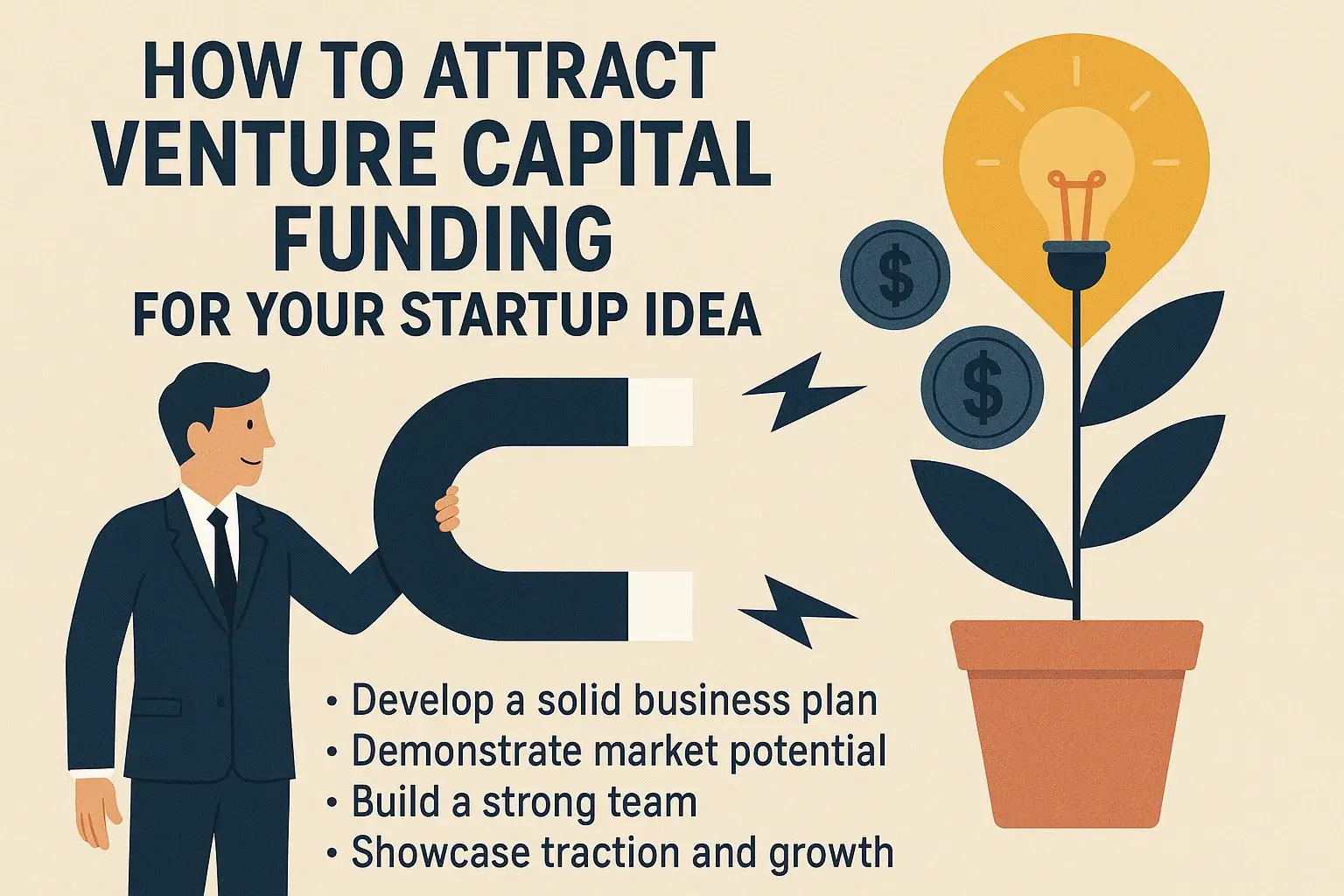How to Attract Venture Capital Funding for Your Startup Idea

How to Attract Venture Capital Funding for Your Startup Idea
Your step-by-step guide to successfully attracting venture capital funding for your startup in 2025. Learn how to build a compelling pitch deck, develop investor relations, identify the right VC firms, and master the fundraising process—optimized for high CPC keywords like venture capital funding, startup funding strategies, VC pitch tips, and raising startup capital for maximum SEO and eCPM.
Table of Contents
- Introduction: Why Venture Capital Funding is Vital for Startups
- Understanding Venture Capital & Its Role
- Preparation: How to Get Your Startup Ready
- Building a High-Impact Pitch Deck
- Finding the Right Venture Capital Firms
- Networking & Building Relationships with Investors
- Navigating the Fundraising Process
- Valuing Your Startup for Investment
- Understanding Term Sheets and Negotiations
- Post-Funding Best Practices
- Common Fundraising Mistakes to Avoid
- Frequently Asked Questions
- Conclusion
Introduction: Why Venture Capital Funding is Vital for Startups
For pioneering startups aiming to scale rapidly, venture capital funding is often critical in 2025. VCs provide not only the financial firepower but also expertise, network access, and market validation. Understanding how to attract venture capital investors and structure your funding rounds increases your chance of success in the competitive startup ecosystem.
Understanding Venture Capital & Its Role
Venture capitalists invest in promising startups at various stages—from seed to growth—in exchange for equity. Unlike traditional loans, VC funding is high-risk, high-reward, aiming to generate significant returns via exits or IPOs. Knowing VC expectations, cycles, and decision criteria helps founders tailor their approach effectively.
Preparation: How to Get Your Startup Ready
- Solidify Your Business Model: Clear understanding of your product-market fit and revenue streams.
- Develop Traction Metrics: Demonstrate user growth, customer engagement, and early revenue.
- Legal and Financial Readiness: Clean cap table, proper business entity, and clear financial records.
- Compelling Storytelling: Craft a vision that resonates with investors’ desire for disruption and scale.
Building a High-Impact Pitch Deck
Your pitch deck is the frontline tool to catch VC interest:
- Problem & Opportunity: Clearly define the pain point and your solution.
- Market Size & Trends: Quantify your total addressable market and growth opportunity.
- Product/Service Overview: Demonstrate your product’s uniqueness and competitive advantage.
- Business Model: Explain how you generate revenue sustainably.
- Traction & Milestones: Showcase growth metrics, partnerships, and user feedback.
- Financial Projections: Present realistic forecasts and budget plans.
- Team: Highlight relevant experience and capabilities of your founding team.
- Funding Ask & Use of Proceeds: Specify how much capital you need and its allocation.
Finding the Right Venture Capital Firms
- Target Relevant Investors: Focus on VCs who specialize in your industry, stage, and geography.
- Use VC Databases and Platforms: Crunchbase, AngelList, PitchBook to research firms and partners.
- Seek Warm Introductions: Leverage your network to get referrals from trusted sources.
- Attend Industry Events & Demo Days: Build face-to-face connections and credibility.
Networking & Building Relationships with Investors
- Maintain consistent communication and share milestone updates.
- Request feedback and iterate your pitch and product based on input.
- Show openness to advice, partnership, and long-term collaboration.
- Build trust by delivering on promises and transparency.
Navigating the Fundraising Process
- Initial Pitch & Meetings: Make a strong impression and answer due diligence questions.
- Due Diligence: Prepare to provide detailed financials, customer references, legal documents.
- Term Sheet Negotiation: Understand key terms to protect your startup’s interests.
- Closing & Funding: Complete legal requirements, sign agreements, and receive capital.
Valuing Your Startup for Investment
Startup valuation is a complex process balancing market potential, traction, team strength, competitiveness, and comparable transactions. Approach valuation realistically but optimistically—overvaluation can deter investors, undervaluation can dilute your stake.
Understanding Term Sheets and Negotiations
- Key Terms: Equity share, liquidation preference, board seats, anti-dilution protections, vesting schedules.
- Negotiation Tips: Engage experienced legal counsel, prioritize governance control, and protect founder equity.
- Common Pitfalls: Avoid overly restrictive terms that limit future fundraising or operational flexibility.
Post-Funding Best Practices
- Maintain regular investor updates on milestones, challenges, and financials.
- Use funding to execute growth plans efficiently and hit key KPIs.
- Leverage investor networks for hiring, partnership, and market expansion.
- Keep governance transparent and proactive to build trust and readiness for future rounds.
Common Fundraising Mistakes to Avoid
- Rushing the fundraising without adequate preparation or product-market fit.
- Lacking clear communication or realistic financials in your pitch.
- Ignoring feedback from investors and failing to follow up appropriately.
- Accepting unfavorable terms due to desperation or lack of legal counsel.
- Neglecting ongoing investor relations after closing funding rounds.
Frequently Asked Questions
Q1: How much equity should I expect to give up to VCs?
Typically 10–30% per funding round; varies greatly based on stage, valuation, and investor appetite.
Q2: When is the best time to seek venture capital funding?
Once you have a validated product, some market traction, and a scalable business model, usually in seed or Series A.
Q3: Can I raise VC funding without a product?
It’s challenging; VCs prefer at least a prototype or MVP with user validation to reduce risk.
Q4: How long does fundraising typically take?
Fundraising cycles often last 3–6 months, including pitching, due diligence, negotiation, and closing.
Q5: Do VCs offer support beyond capital?
Yes, they often provide mentorship, strategic advice, hiring support, and access to their network.
Conclusion
Attracting venture capital funding for your startup idea in 2025 requires preparation, clarity, and persistence. By developing a compelling pitch deck, targeting the right investors, nurturing relationships, and navigating the fundraising process with savvy, you position your startup for accelerated growth and success. Start building your investor roadmap today and turn your vision into the next great venture backed by strategic capital.
Comments (3)